PROJ6006: Organisational Behaviour and People Management Discussion
VerifiedAdded on 2023/05/30
|6
|914
|228
Discussion Board Post
AI Summary
This discussion post examines key concepts in Organisational Behaviour and their application to project management. It delves into the types of power a team leader can utilize, including legitimate, informational, and persuasive power, and how these influence team performance and project success. The post differentiates between influence and manipulation, highlighting the benefits of using multiple influence sources. Furthermore, it explores the advantages of global project teams, particularly in complex projects, while also addressing the challenges project managers face in managing international teams, such as cultural differences and communication barriers. Finally, the post suggests strategies to mitigate these challenges, including open discussions about cultural differences, the use of integrated communication platforms, and regular team meetings to foster participation and a sense of unity.
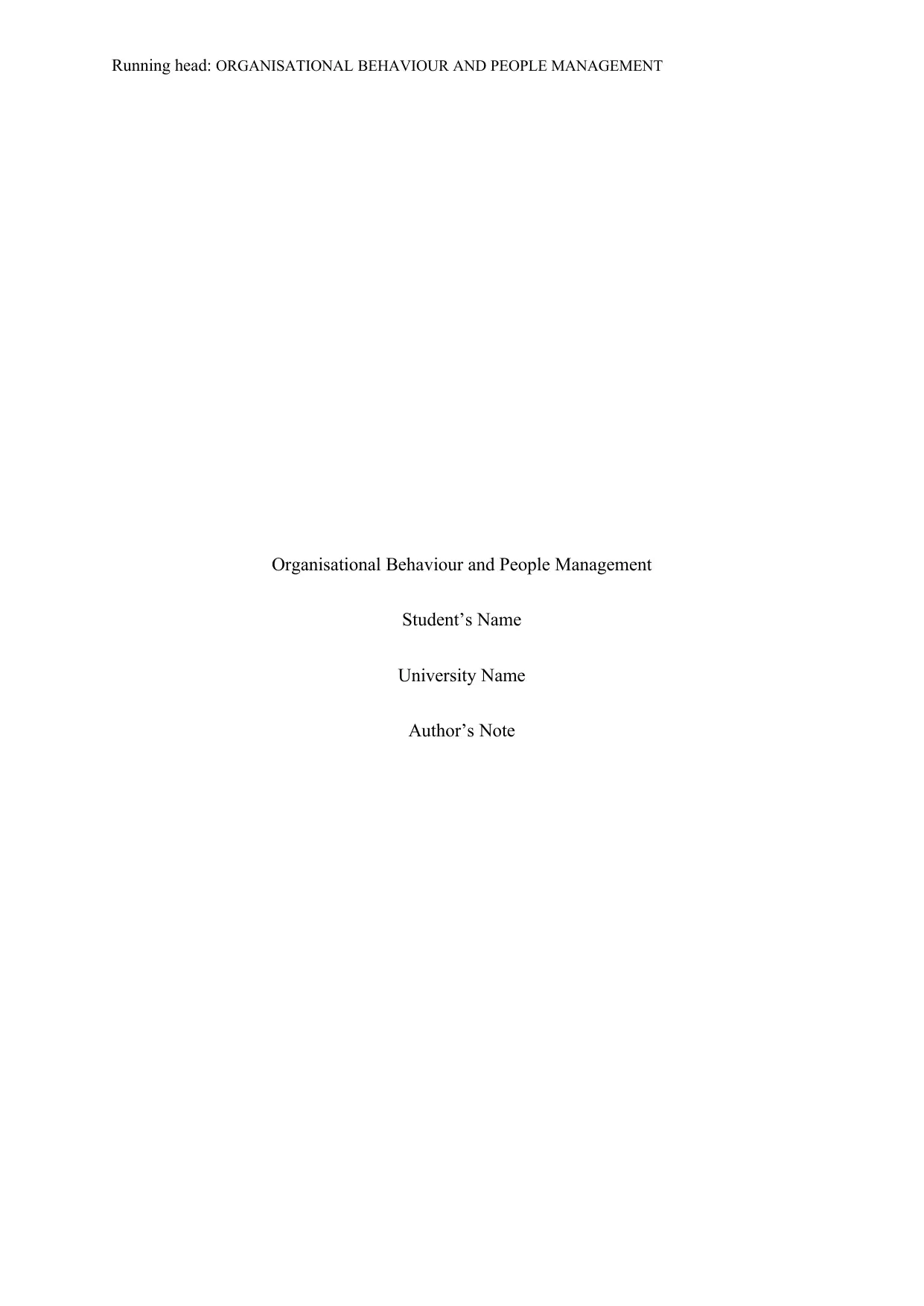
Running head: ORGANISATIONAL BEHAVIOUR AND PEOPLE MANAGEMENT
Organisational Behaviour and People Management
Student’s Name
University Name
Author’s Note
Organisational Behaviour and People Management
Student’s Name
University Name
Author’s Note
Paraphrase This Document
Need a fresh take? Get an instant paraphrase of this document with our AI Paraphraser
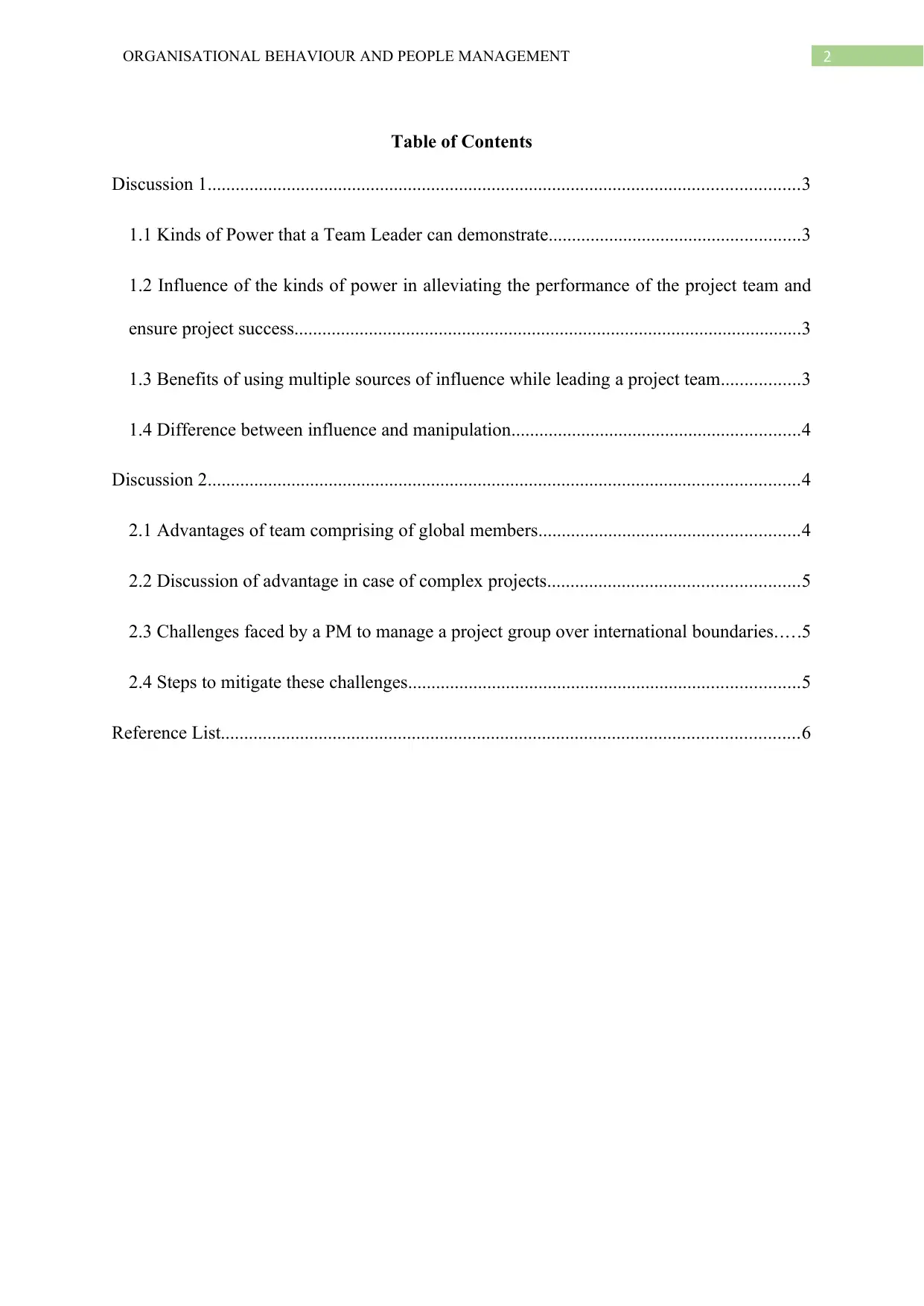
2ORGANISATIONAL BEHAVIOUR AND PEOPLE MANAGEMENT
Table of Contents
Discussion 1...............................................................................................................................3
1.1 Kinds of Power that a Team Leader can demonstrate......................................................3
1.2 Influence of the kinds of power in alleviating the performance of the project team and
ensure project success.............................................................................................................3
1.3 Benefits of using multiple sources of influence while leading a project team.................3
1.4 Difference between influence and manipulation..............................................................4
Discussion 2...............................................................................................................................4
2.1 Advantages of team comprising of global members........................................................4
2.2 Discussion of advantage in case of complex projects......................................................5
2.3 Challenges faced by a PM to manage a project group over international boundaries.....5
2.4 Steps to mitigate these challenges....................................................................................5
Reference List............................................................................................................................6
Table of Contents
Discussion 1...............................................................................................................................3
1.1 Kinds of Power that a Team Leader can demonstrate......................................................3
1.2 Influence of the kinds of power in alleviating the performance of the project team and
ensure project success.............................................................................................................3
1.3 Benefits of using multiple sources of influence while leading a project team.................3
1.4 Difference between influence and manipulation..............................................................4
Discussion 2...............................................................................................................................4
2.1 Advantages of team comprising of global members........................................................4
2.2 Discussion of advantage in case of complex projects......................................................5
2.3 Challenges faced by a PM to manage a project group over international boundaries.....5
2.4 Steps to mitigate these challenges....................................................................................5
Reference List............................................................................................................................6
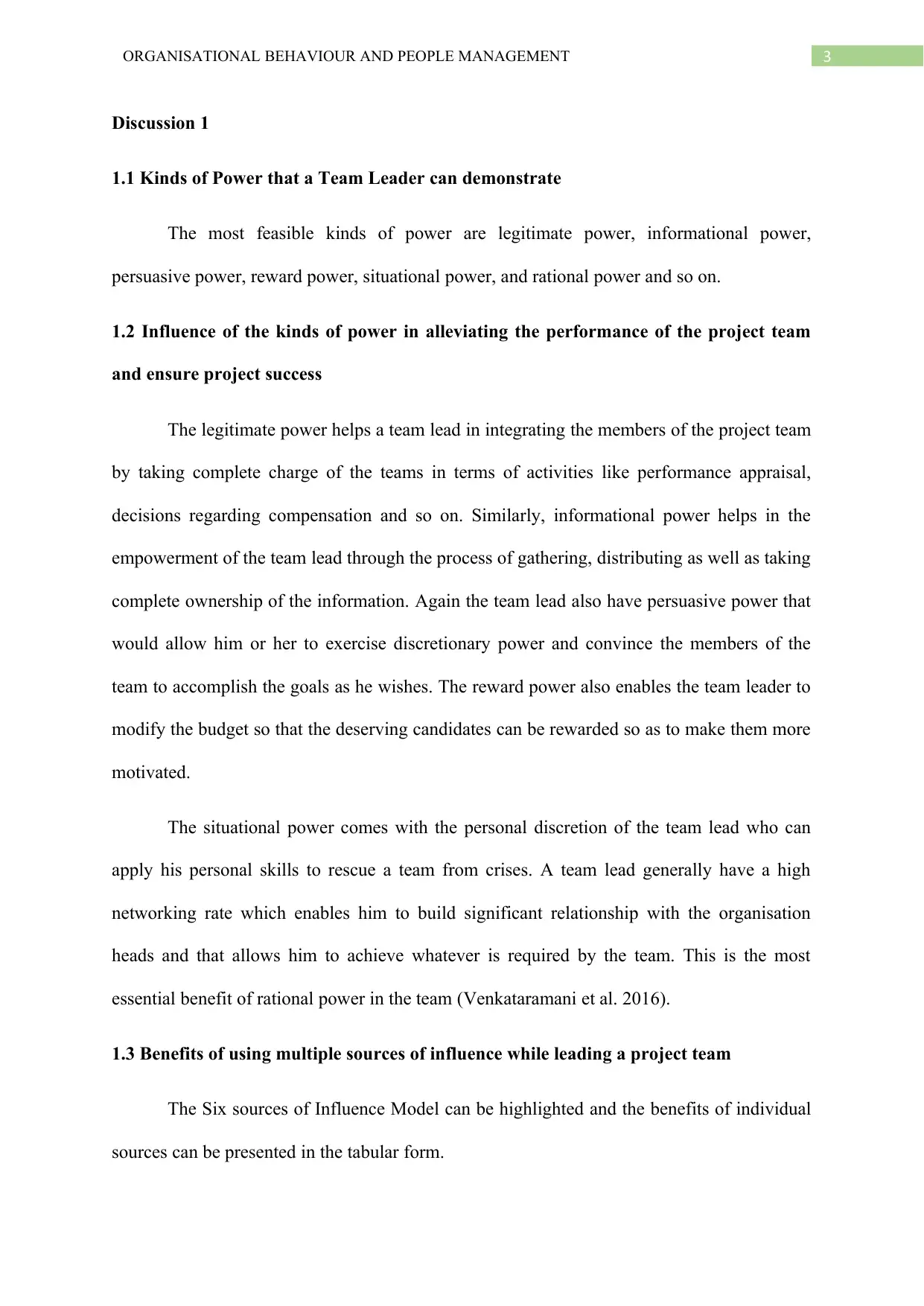
3ORGANISATIONAL BEHAVIOUR AND PEOPLE MANAGEMENT
Discussion 1
1.1 Kinds of Power that a Team Leader can demonstrate
The most feasible kinds of power are legitimate power, informational power,
persuasive power, reward power, situational power, and rational power and so on.
1.2 Influence of the kinds of power in alleviating the performance of the project team
and ensure project success
The legitimate power helps a team lead in integrating the members of the project team
by taking complete charge of the teams in terms of activities like performance appraisal,
decisions regarding compensation and so on. Similarly, informational power helps in the
empowerment of the team lead through the process of gathering, distributing as well as taking
complete ownership of the information. Again the team lead also have persuasive power that
would allow him or her to exercise discretionary power and convince the members of the
team to accomplish the goals as he wishes. The reward power also enables the team leader to
modify the budget so that the deserving candidates can be rewarded so as to make them more
motivated.
The situational power comes with the personal discretion of the team lead who can
apply his personal skills to rescue a team from crises. A team lead generally have a high
networking rate which enables him to build significant relationship with the organisation
heads and that allows him to achieve whatever is required by the team. This is the most
essential benefit of rational power in the team (Venkataramani et al. 2016).
1.3 Benefits of using multiple sources of influence while leading a project team
The Six sources of Influence Model can be highlighted and the benefits of individual
sources can be presented in the tabular form.
Discussion 1
1.1 Kinds of Power that a Team Leader can demonstrate
The most feasible kinds of power are legitimate power, informational power,
persuasive power, reward power, situational power, and rational power and so on.
1.2 Influence of the kinds of power in alleviating the performance of the project team
and ensure project success
The legitimate power helps a team lead in integrating the members of the project team
by taking complete charge of the teams in terms of activities like performance appraisal,
decisions regarding compensation and so on. Similarly, informational power helps in the
empowerment of the team lead through the process of gathering, distributing as well as taking
complete ownership of the information. Again the team lead also have persuasive power that
would allow him or her to exercise discretionary power and convince the members of the
team to accomplish the goals as he wishes. The reward power also enables the team leader to
modify the budget so that the deserving candidates can be rewarded so as to make them more
motivated.
The situational power comes with the personal discretion of the team lead who can
apply his personal skills to rescue a team from crises. A team lead generally have a high
networking rate which enables him to build significant relationship with the organisation
heads and that allows him to achieve whatever is required by the team. This is the most
essential benefit of rational power in the team (Venkataramani et al. 2016).
1.3 Benefits of using multiple sources of influence while leading a project team
The Six sources of Influence Model can be highlighted and the benefits of individual
sources can be presented in the tabular form.
⊘ This is a preview!⊘
Do you want full access?
Subscribe today to unlock all pages.

Trusted by 1+ million students worldwide
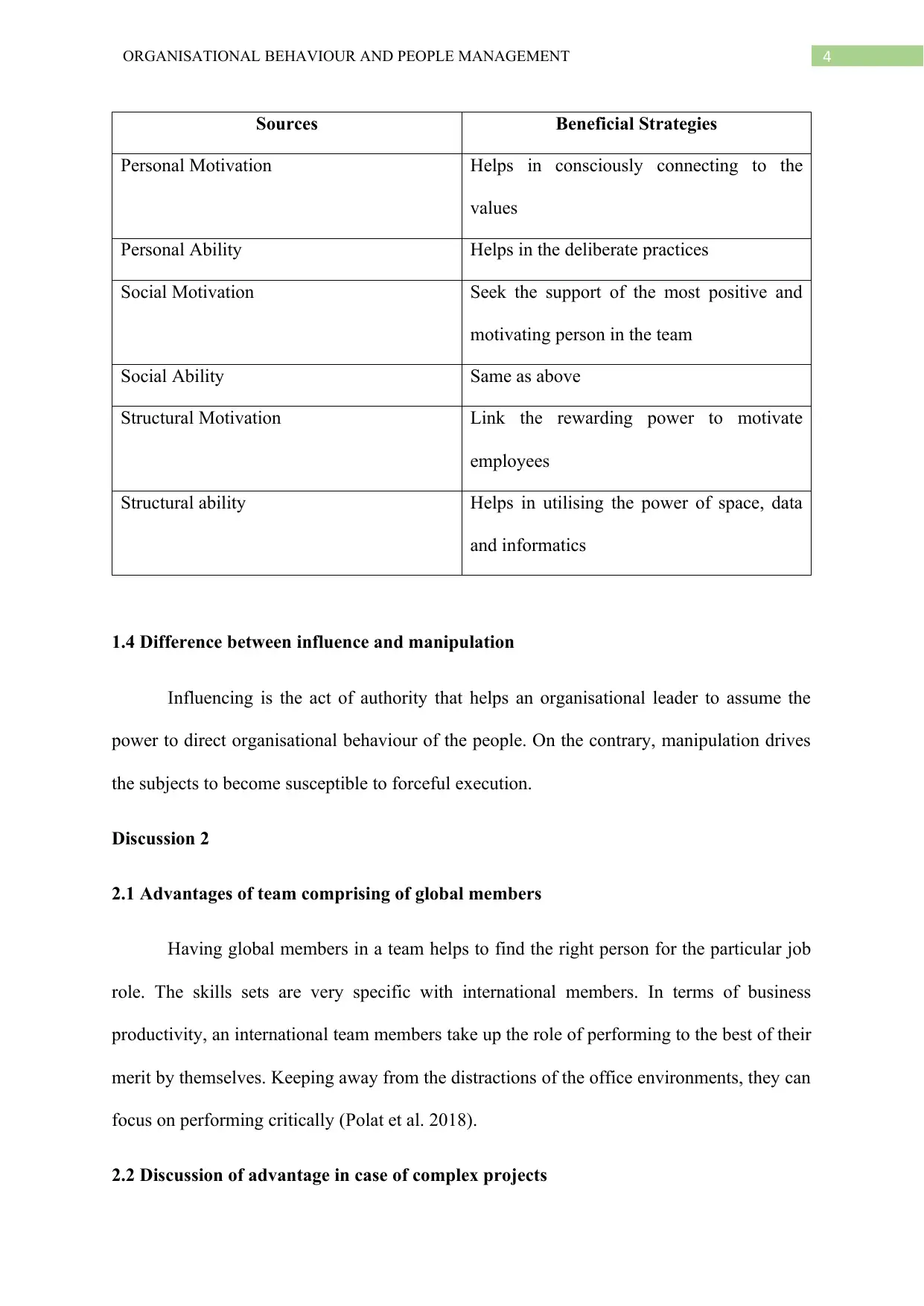
4ORGANISATIONAL BEHAVIOUR AND PEOPLE MANAGEMENT
Sources Beneficial Strategies
Personal Motivation Helps in consciously connecting to the
values
Personal Ability Helps in the deliberate practices
Social Motivation Seek the support of the most positive and
motivating person in the team
Social Ability Same as above
Structural Motivation Link the rewarding power to motivate
employees
Structural ability Helps in utilising the power of space, data
and informatics
1.4 Difference between influence and manipulation
Influencing is the act of authority that helps an organisational leader to assume the
power to direct organisational behaviour of the people. On the contrary, manipulation drives
the subjects to become susceptible to forceful execution.
Discussion 2
2.1 Advantages of team comprising of global members
Having global members in a team helps to find the right person for the particular job
role. The skills sets are very specific with international members. In terms of business
productivity, an international team members take up the role of performing to the best of their
merit by themselves. Keeping away from the distractions of the office environments, they can
focus on performing critically (Polat et al. 2018).
2.2 Discussion of advantage in case of complex projects
Sources Beneficial Strategies
Personal Motivation Helps in consciously connecting to the
values
Personal Ability Helps in the deliberate practices
Social Motivation Seek the support of the most positive and
motivating person in the team
Social Ability Same as above
Structural Motivation Link the rewarding power to motivate
employees
Structural ability Helps in utilising the power of space, data
and informatics
1.4 Difference between influence and manipulation
Influencing is the act of authority that helps an organisational leader to assume the
power to direct organisational behaviour of the people. On the contrary, manipulation drives
the subjects to become susceptible to forceful execution.
Discussion 2
2.1 Advantages of team comprising of global members
Having global members in a team helps to find the right person for the particular job
role. The skills sets are very specific with international members. In terms of business
productivity, an international team members take up the role of performing to the best of their
merit by themselves. Keeping away from the distractions of the office environments, they can
focus on performing critically (Polat et al. 2018).
2.2 Discussion of advantage in case of complex projects
Paraphrase This Document
Need a fresh take? Get an instant paraphrase of this document with our AI Paraphraser
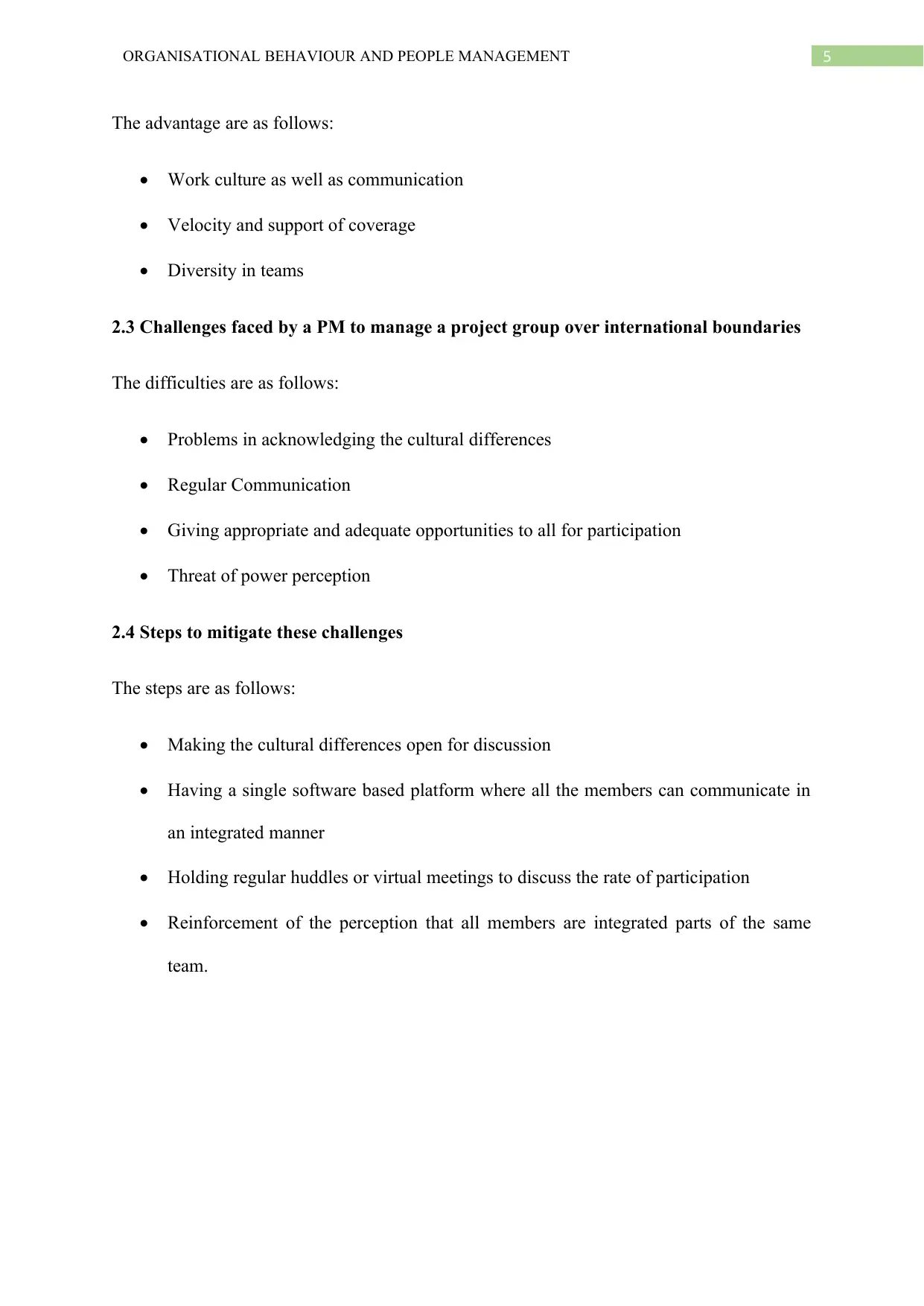
5ORGANISATIONAL BEHAVIOUR AND PEOPLE MANAGEMENT
The advantage are as follows:
Work culture as well as communication
Velocity and support of coverage
Diversity in teams
2.3 Challenges faced by a PM to manage a project group over international boundaries
The difficulties are as follows:
Problems in acknowledging the cultural differences
Regular Communication
Giving appropriate and adequate opportunities to all for participation
Threat of power perception
2.4 Steps to mitigate these challenges
The steps are as follows:
Making the cultural differences open for discussion
Having a single software based platform where all the members can communicate in
an integrated manner
Holding regular huddles or virtual meetings to discuss the rate of participation
Reinforcement of the perception that all members are integrated parts of the same
team.
The advantage are as follows:
Work culture as well as communication
Velocity and support of coverage
Diversity in teams
2.3 Challenges faced by a PM to manage a project group over international boundaries
The difficulties are as follows:
Problems in acknowledging the cultural differences
Regular Communication
Giving appropriate and adequate opportunities to all for participation
Threat of power perception
2.4 Steps to mitigate these challenges
The steps are as follows:
Making the cultural differences open for discussion
Having a single software based platform where all the members can communicate in
an integrated manner
Holding regular huddles or virtual meetings to discuss the rate of participation
Reinforcement of the perception that all members are integrated parts of the same
team.
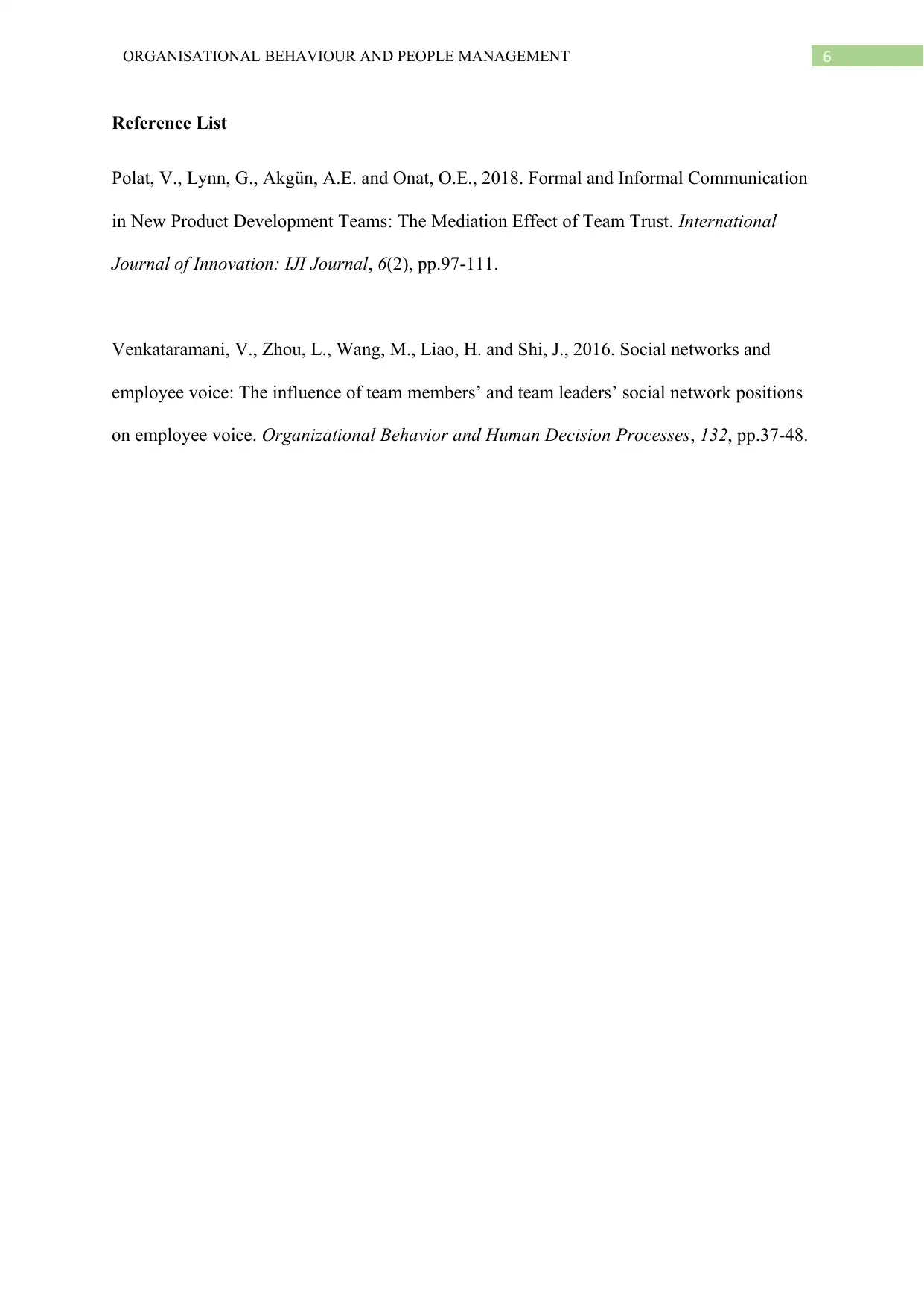
6ORGANISATIONAL BEHAVIOUR AND PEOPLE MANAGEMENT
Reference List
Polat, V., Lynn, G., Akgün, A.E. and Onat, O.E., 2018. Formal and Informal Communication
in New Product Development Teams: The Mediation Effect of Team Trust. International
Journal of Innovation: IJI Journal, 6(2), pp.97-111.
Venkataramani, V., Zhou, L., Wang, M., Liao, H. and Shi, J., 2016. Social networks and
employee voice: The influence of team members’ and team leaders’ social network positions
on employee voice. Organizational Behavior and Human Decision Processes, 132, pp.37-48.
Reference List
Polat, V., Lynn, G., Akgün, A.E. and Onat, O.E., 2018. Formal and Informal Communication
in New Product Development Teams: The Mediation Effect of Team Trust. International
Journal of Innovation: IJI Journal, 6(2), pp.97-111.
Venkataramani, V., Zhou, L., Wang, M., Liao, H. and Shi, J., 2016. Social networks and
employee voice: The influence of team members’ and team leaders’ social network positions
on employee voice. Organizational Behavior and Human Decision Processes, 132, pp.37-48.
⊘ This is a preview!⊘
Do you want full access?
Subscribe today to unlock all pages.

Trusted by 1+ million students worldwide
1 out of 6
Related Documents
Your All-in-One AI-Powered Toolkit for Academic Success.
+13062052269
info@desklib.com
Available 24*7 on WhatsApp / Email
![[object Object]](/_next/static/media/star-bottom.7253800d.svg)
Unlock your academic potential
Copyright © 2020–2025 A2Z Services. All Rights Reserved. Developed and managed by ZUCOL.





